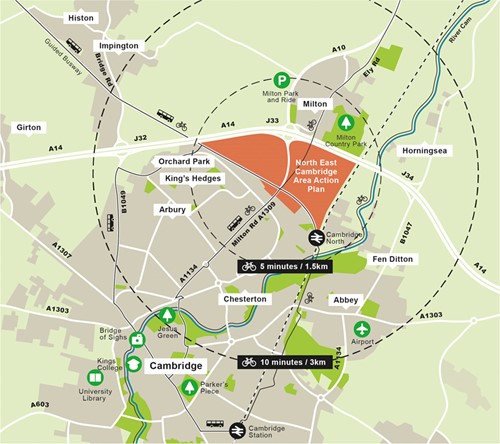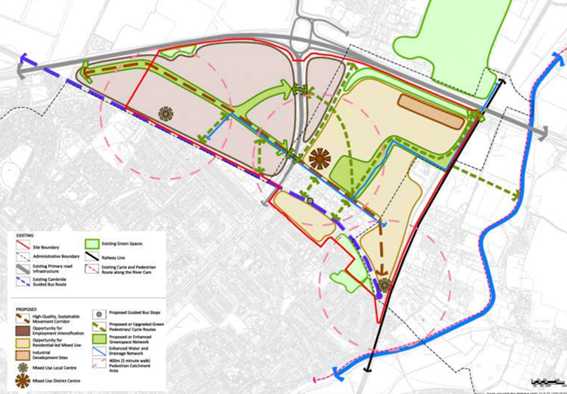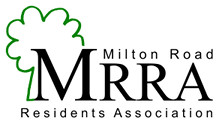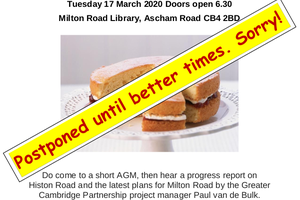The MRRA's Response to the NEC Consultation
Posted on Monday 5 October 2020
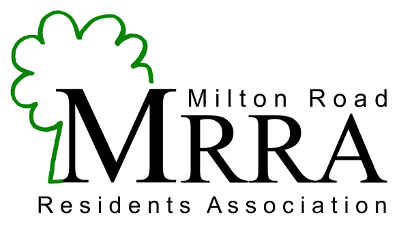
The following is our response to the North East Cambridge consultation. You can find a download link at the bottom of this page.
North East Cambridge consultation Response by Milton Road Residents’ Association
Introduction
This consultation was advertised to take place from 9am Monday 27 July to 5pm Monday 5 October 2020. By mid-August none of the residents along Milton Road had received a leaflet. MRRA chairman, Charles Nisbet, was advised to call Hana Loftus and they eventually arrived on 28 August, over a month after the consultation started.
We heard other areas in North Cambridge had also not received a leaflet and that only 20,000 had been printed, not enough for the area let alone anyone wanting to reply from south Cambridge or the villages that the development would affect.
What is more we discovered that if a resident had not had a copy delivered, to order a copy would cost £20. This is totally unacceptable as it is censoring many and limiting potential for comment.
1. What do you think about our vision for North East Cambridge?
-
Initially, the design was to produce more housing. Cambridge does need more housing but this design is cramped into a restricted space with people living very close to each other with very little green space.
-
The initial design included housing on the Science Park, now rejected by Trinity College in favour of more office blocks so the ‘mix of housing and jobs does not apply to half the site.
-
Who are the houses intended for? Although the area is next to the Science Park – a centre for innovation where most jobs are specialist, attracting staff from far afield, and with pay rates that give access to high-end housing – it is doubtful that many SP employees and their families will live in this new area.
-
Creating an area where the jobs-to-people ratio is skewed will force Cambridge house prices and rents even higher. Cambridge is already the most unequal city in the UK, this development will make it worse.
-
The ‘vision’ is to build one of the most densely developed areas in the UK, maybe even Western Europe. With minimal integral green space at its core, this area is unlikely to attract the mix of people implied in the consultation material.
-
MRRA does not object to the water treatment plant being sited where it is, it has recently gone through an update and it cannot be seen from the road. The whole design depends upon it being moved into the green belt, with many protesters objecting as it will cause a blot on the landscape.
-
Is the move – part-funded by £227M of public money – necessarily being done to improve the processing of the City’s waste, or is it really in order to free up land for more housing and thus developers’ profits?
-
The design is continually changing since the first plans were shown: the green road connecting to the Science Park has been removed, the flats are getting higher at each rethink and the green space is disappearing. To make up for this the developers are seeking to include existing green spaces in Cambridge such as Milton Country Park and Stourbridge Common which are already at capacity.
2. Are we creating the right walking and cycling connections to the surrounding areas?
-
We are pleased to see the design encourages walking and cycling in the development, but the knock-on effect will cause problems of overcrowding on existing and planned adjacent infrastructure for walking and cycling.
-
Milton Road will have major roadworks soon and will encourage cycling and walking but will the cycleways be wide enough for the increased population? The proposed cycleways will be 2.5m, some areas where the road is narrower the cycle lanes will be even smaller at 1.5m. At our last counts before the epidemic 534 cyclists were counted between 8 and 9am near Arbury Road. There will be extra pressure with people cycling from the new development put on the area.
-
The area around the river tow path is already crowded and when the Chisholm Trail plus the Greenway with the additional housing at Waterbeach is in place, it is unlikely to be sufficient to carry those extra cyclists and pedestrians.
-
The green bridge in the original plans could have helped relieve some of the congestion resulting from cycling from the Science Park to the new area, and should be looked at again. A subway will be a poor second best – they are never nice places to cycle through and tend to fill with the fumes from the cars and lorries on that busy part of Milton Road.
-
Walking and cycling around Cambridge North Station needs to be studied carefully. Brookgate developers did not make allowances for the number of cyclists around Cambridge Station and made it very difficult to cross the square. Traffic and cyclists are forced to mix with very dangerous outcomes. The developers need to learn by their mistakes. The country is embracing a cycling revolution and cyclists need to be given a much higher priority at the planning stage.
-
Cycle parking at Cambridge North Station needs to be monitored by security guards to prevent the high levels of theft that exists at the present time.
-
The plans do not show parking for cycles outside the new homes. There needs to be safe, free, covered cycle parking throughout the development not only for standard cycles but also cargo bikes.
3. Are the new ‘centres’ in the right place and do they include the right mix of activity?
-
The centres are very patchy. This could be because of several developers being involved. The original plans included housing on the Science Park, which was abandoned so there is now one ‘centre’ in the area exclusively for work, with others being mixed activity.
-
The industry will be staying on the site. One of these is the concrete mixing site. Dust levels can impact the respiratory health not only of the workers but also the 18,000 or more residents who will live near it. There needs to be strict rules to prevent poor air quality.
-
The flats will be close to the A14, a very busy road with a very high proportion of HGVs. There needs to be good provision in place to stop air and noise pollution.
4. Do we have the right balance between new jobs and new homes?
-
The district appears to be made up entirely of flats, where is the option of a three-bedroom home with garden, which is the most popular form of home in the UK?
-
Cambridge needs more homes as the expected job market grows. The development will have 8,000 new homes, housing approximately 18-19,000 people with around 11,000 expected to be in employment. The vision is to create 20,000 jobs meaning more homes will have to be built to accommodate them or 9,000 people will need to get to work from outside the development putting even more pressure on resources and homes and forcing up costs of rent and house prices.
5. Are we planning for the right community facilities?
-
There was talk of a concert hall, which appears to have been abandoned: Cambridge needs more venues like that and the area would be ideal. It would be good to reduce the housing and make way for more community space, which is lacking in North Cambridge. To make a really well-designed area that integrates with neighbouring ones look at it from the view of North Cambridge residents rather than the developer’s profit margin.
-
There are a lot of allotments in North Cambridge and long waiting lists for plots to grow fruit and vegetables. Allotments would be a great asset to the area which has very little green space and no gardens. In recent years there has been a resurgence of people growing their own vegetables and it has been proved that it helps mental health.
-
There seems to be no provision for any nursery schools, and despite expecting approximately 19,000 residents, there are no plans to build a secondary school. Where will these students be educated? The closest school is North Cambridge Academy but it is unlikely it will have enough places for the children of NE Cambridge. Many schools in Cambridge are at, or close to, capacity and with a boom in housing they will soon be an acute shortage of schools. If by the time a new school is needed will the allocated space in case one is needed in future already be built on and will there be enough land for playing fields etc?
6. Do you think our approach to distributing heights and densities is appropriate for the location?
-
The high skyline is going to make a huge impact on Milton Road and many residents in North Cambridge will see the towering flats from their homes. It will also give a feeling of overcrowding and being overlooked by the people in the top of the flats. It will make a huge difference to the people living in the area who are used to seeing the sky.
-
The new flats in bright colours will dominate the sky and that style will soon become outdated. Buildings should reflect their surroundings, not stick out like a sore thumb.
-
Edward Leigh from Smarter Cambridge Transport has mentioned the very high density of the area and compared it to areas in London. The proposals for the new area have one of the highest densities in the UK, but the difference is that these proposals have far less green space close by. So yes, the area will be far too dense for its position and the lack of green space can lead to mental health problems and further strains upon the medical services.
-
The high density will also put severe pressure on our water table, which is already far too low with the situation getting worse with every new development.
7. .Are we planning for the right mix of public open spaces?
-
No. The green space surrounding the area is already at capacity and will be unable to cope with an extra 18-19.000 people wanting to walk, run, exercise, take their dog out or have a picnic with their kids.
-
The plan seems to concentrate on Milton Country Park as the green space, which is already used to capacity.
-
Compared to other developments in the Cambridge there is very little space per person. In the new development at Trumpington on the other side of Cambridge they have 90 hectares of space for 3,500 homes; here it is to be 10 hectares for 8,000 homes
8. Are we doing enough to improve biodiversity in and around North East Cambridge?
-
The site at present is a wonderful wildlife area with large trees and plenty of birds and small animals. There is also a small natural drain with lovely clear water full of fish. These will all go to make the new development. It is difficult to see how building will increase biodiversity.
9. Are we doing enough to discourage car travel into this area?
-
There is still no provision for an extra road linking the area between Cambridge North and Fen Road. The increase in trains along the railway means the railway crossing is closed for long times during the day and people and businesses are effectively locked out of their area for quite a lot of the day. There needs to be an extension of one of the roads in the new development going into this area.
-
Milton Road Residents' Association is pleased to see that the development aims to reduce car use and encourage cycling and walking, but cars are not banned. There is just a hopeful expectation that there will be less. If that proves not to be the case and if little provision has been made for car parking, then car owners will simply park in the surrounding streets, mainly in East Chesterton. The leaflet states that there will be 0.5 parking spaces per new home. That means potentially 4,000 extra parking spaces in North Cambridge.
-
This also raises questions about deliveries, traders, etc, coming into the area. Where will they park? Most deliveries are under time constraints and therefore park directly outside people’s homes. Most traders need to go back and forth to their vans. The roads are to be 6.5m wide and there could be any amount of people parked outside the flats during day and night.
-
The leaflet states there will be ‘no additional vehicle movements on Milton Road and King’s Hedges’. How on earth can this be true? There will be the endless HGVs, cranes, all sorts of vehicles coming as they build the development, along with extra noise. After that there will be people outside the area driving to the new jobs plus all the vehicles that the residents will use and those that will deliver their food and all the goods they have ordered on line. And of course there will have to be extra buses.
10. Are we maximising the role that development at North East Cambridge has to play in responding to the climate crisis?
-
There are no commitments to the highest construction standards and the brightly coloured flats will soon look out of date.
-
There does not appear to be any mention of renewable energy. We are going through a climate crisis and the development needs to focus on conserving and reusing water wherever possible. The half-hearted ‘proposes robust targets’ and ‘encourages low carbon lifestyles’ is a passing acknowledgement and does not mean the developers will actually do this if costs prove too high. At very least every roof should be required to be covered in solar panels.
-
Unless the development is built to the highest standards, there is a risk that it will become dilapidated after a few years and further energy will have to be expended in rebuilding or demolishing it.

